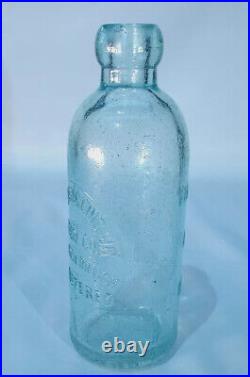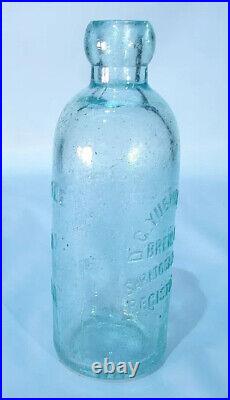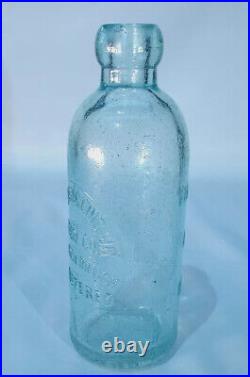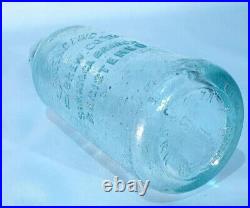1890s YUENGLING beer SARATOGA NY. Blob top HUTCH SODA BOTTLE. SALE












Little History - found on the internet.... The brewery grew into a sizable operation that, according to the. Could produce in excess of 400 barrels per day. A photograph of the James River Steam Brewery. While the brewery no longer exists, we are lucky enough to have several fantastic descriptions of the brewery while it was in operation.
Historian Mike Gorman documented several of them for this fantastic article about the Yuengling operation in Richmond. Gives us another opportunity to look into the past. The following article comes from the July 30, 1869 edition of the. James River Steam Brewery - How Beer is Made. The large quantity of malt liquors now consumed by our people makes the manufactory necessary to supply its demand quite an important one, and the fact that we have in Richmond a brewery of sufficient capacity to supply our whole State with malt liquors should not go unappreciated. Thousands of dollars could be kept in circulation in our midst if our people would encourage home institutions, and the James River Steam Brewery is one which presents strong claims to our malt liquor dealers for their support. This brewery was built here in 1866, and was completed in the latter part of that year, or early in the next.The building is on the largest scale, and is one of the most prominent along the river bank, and at once attracts the eye as a most substantial structure. Betz, Yuengling & Beyer were the first proprietors, but it is now in the hands of Mr.
An enterprising and popular young German, the son of one of the largest brewers in Pennsylvania. The superintendent of the establishment is Mr. Robinson, who came with Mr. As to the process of making beer is new to most of our people. We propose to give a brief idea of its manufacture, with especial reference to the James River Brewery.
First we have the [James] river, containing the best beer-water in the country, then have the brewery with its malt and its "'ops, " and everything else necessary in the premises. The tubs and machinery are all ready for a brewing. The malt is taken and ground in a mill, which is on the first floor, the power being furnished by a forty horse power steam engine, which is, next to the "boss, " the prime mover in the establishment. The malt proper is then conveyed up on the fourth floor where the mesh-tubs are. On the top floor are two immense cisterns containing 14,000 gallons of water, which is forced up by means of steam.This constitutes the reservoir for supplying the brewery. Water is run into the mesh-tubs and heated by means of steam piping in the bottom, and the malt is next put in. Then commences the mashing, which consists in a thorough stirring up of the malt in the boiling water in order to extract the saccharine matter. This process completed, the boiling-tub is next introduced.
This is on the lower floor, and is of the same size as the mesh-tub. The liquor made by the meshing being boiled and then drained off into the hopsack, and the hops being introduced, the mixing process continues.This completed, we have the cooling process. The mixture last produced is drained through a metallic bottom full of holes, which catches the hops and all dregs, and passed through a refrigerator, which has the appearance of a patent steam-heating apparatus. The pipes are laid in the same manner, but instead of being filled with steam are filled with very cold spring water, which cools the beer thoroughly as it passes over them on its way into the fermenting tub. These are huge wooden vats, strongly hooped, and close, with the exception of a hole at the top, through which the process can be inspected. The fermentation takes from twenty-four to thirty-six hours, and the beer is then transferred into the huge store casks in the vaults and kept ready for drawing.
All the above operations are most carefully performed by a posse of skillful and experienced workmen, all native Germans. The vaults in this brewery are most elaborately constructed.There are two series of them - four on each side of the building. They are built way down under the ground, and kept as cool and as close as possible. Last year the capacity of these vaults was for about four or five thousand barrels of beer, besides ale and porter. They were supplied accordingly, but the supply was not found to be equal to the demand; so this year Mr. Yuengling added another large vault, which was duly christened by a party of Richmond gentlemen - mostly Germans - as Katrina vault.
There is but little difference in the brewing of ale, beer, and porter, the difference is in the color of the malt used - the lightest is used for ale, and the brownest which, from being slightly charred, acquires a bitter taste - is used for porter. The difference in color is due to the greater or less degree of heat used in drying the malt. After a thorough inspection of the James River Brewery we are convinced that it is as complete an establishment as there is in the country, and in this we are seconded by several German gentlemen from the North. Yuengling spares no expense in his efforts to produce the best of malt liquors, and the fact that he gives satisfaction is evinced by the number of orders he fills through the Southern States.
He has them from as far south as Montgomery, Ala. And he supplies parties in Washington. He uses the best material, he employs the most efficient workmen, and his beer and other malt liquors are as good as anybody need wish for. We hope that our people have long since gotten over their prejudice against anything made at home, and that they can at last appreciate the fact that good things can be made here as, well as in the North. The following are the officers of the brewery: Superintendent, George W. Robinson : head clerk, Charles K. Duncker; head cellarman, Jacob Bear; chief engineer, Martin Mahony. There are fifteen men regularly employed besides the drivers. The capacity of the brewery is two hundred barrels per day, and this of the first-class of malt liquors.If our State cannot be supplied with this, let us know, and another brewery will be built. All that is asked now is that the large capital expended in this way may be confined here. Production at the facility was an impressive operation, but Yuengling and his team faced several major issues that the brewers could never quite overcome.
The defeat of the former Confederacy left Richmond and much of Virginia in ruins. This made it difficult to market and sell the beer to cash-strapped residents. Additionally, the market for beer was almost entirely new to this region of the country.Not so in the South, an area where whiskey predominated and a large German population (excluding the cities) did not exist. These factors ultimately proved ruinous to the business and by 1880, D.
